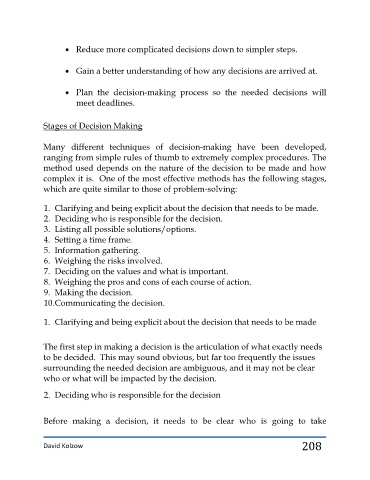Page 208 - 4- Leading_from_Within
P. 208
• Reduce more complicated decisions down to simpler steps.
• Gain a better understanding of how any decisions are arrived at.
• Plan the decision-making process so the needed decisions will
meet deadlines.
Stages of Decision Making
Many different techniques of decision-making have been developed,
ranging from simple rules of thumb to extremely complex procedures. The
method used depends on the nature of the decision to be made and how
complex it is. One of the most effective methods has the following stages,
which are quite similar to those of problem-solving:
1. Clarifying and being explicit about the decision that needs to be made.
2. Deciding who is responsible for the decision.
3. Listing all possible solutions/options.
4. Setting a time frame.
5. Information gathering.
6. Weighing the risks involved.
7. Deciding on the values and what is important.
8. Weighing the pros and cons of each course of action.
9. Making the decision.
10. Communicating the decision.
1. Clarifying and being explicit about the decision that needs to be made
The first step in making a decision is the articulation of what exactly needs
to be decided. This may sound obvious, but far too frequently the issues
surrounding the needed decision are ambiguous, and it may not be clear
who or what will be impacted by the decision.
2. Deciding who is responsible for the decision
Before making a decision, it needs to be clear who is going to take
David Kolzow 208

